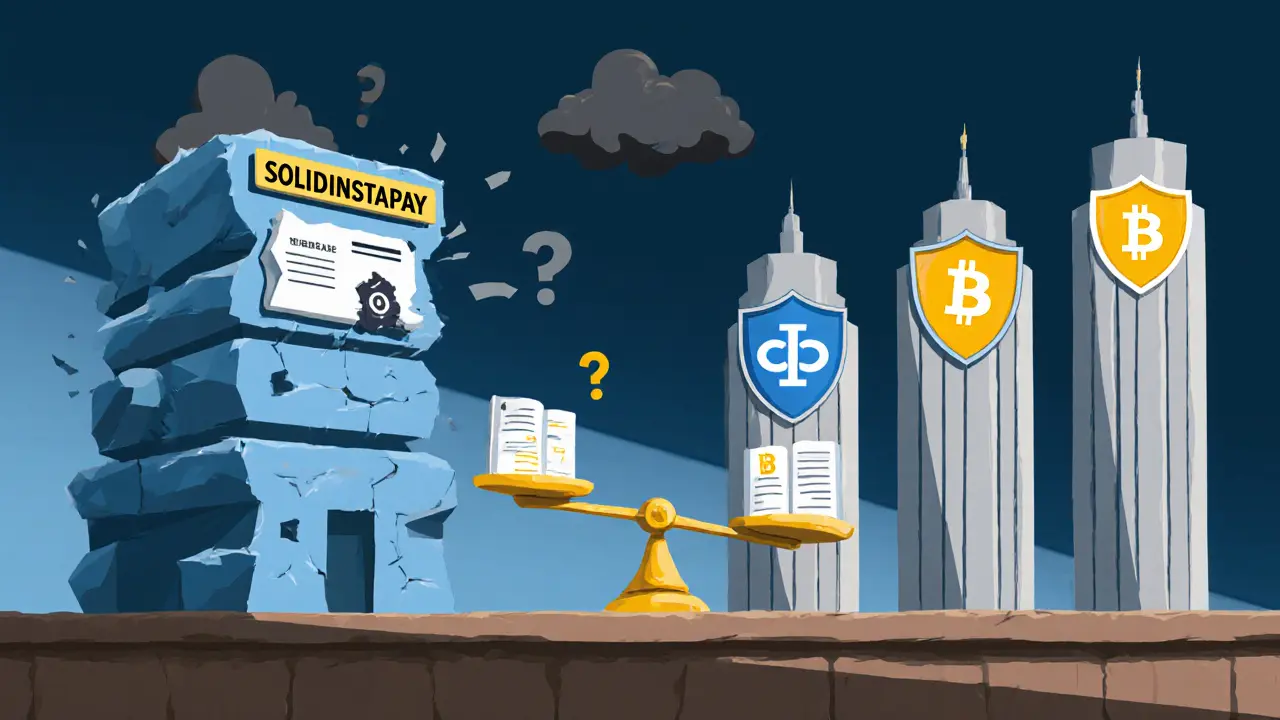Crypto Exchange Risk Assessment Tool
How Risky Is This Exchange?
This tool helps you quickly assess the risk level of cryptocurrency exchanges based on key security and regulatory factors.
Based on industry standards and the findings from the SOLIDINSTAPAY review article.
Risk Assessment Results
When you hear a platform brag about being a "next‑generation" crypto exchange, the first question should be: next‑generation for whom? SOLIDINSTAPAY review uncovers the claims, the gaps, and the red flags that most marketing pages hide.
Key Takeaways
- SOLIDINSTAPAY operates without any verified regulatory license - a medium‑risk warning from multiple watchdogs.
- It lists over 200 digital assets, but no public API, fee schedule, or proof‑of‑reserves can be found.
- Legitimate rivals like Uphold, Gemini, and PrimeXBT provide clear fee structures, insurance, and partial regulatory oversight.
- Expert consensus (AML Rightsize, CryptolegalUK) classifies the exchange as high‑risk and advises avoidance.
- For secure trading, stick to regulated platforms that publish transparent audits and offer customer support.
What Is SOLIDINSTAPAY?
SOLIDINSTAPAY is a cryptocurrency exchange that markets itself as a fully safe and secure platform for buying, selling, and swapping digital assets. The service claims to support more than 200 crypto pairs and to be based in the United Kingdom, but the company’s registration details, licensing information, and security audits remain opaque.
The website lists standard features such as instant deposits, a “secure blockchain exchange” promise, and a generic support email ([email protected]). No white‑paper, no third‑party audit, and no proof‑of‑reserves are publicly available.
Regulatory Status - The Elephant in the Room
Regulation the set of legal permissions and oversight required for financial services is the cornerstone of trust in any exchange. Wikibit’s verification system flags SOLIDINSTAPAY as having “no valid regulation” and assigns it a “Medium potential risk” rating, citing a “Suspicious Regulatory License.” In contrast, platforms like Uphold and Gemini are registered with the FCA, SEC, or other major regulators, providing users legal recourse if funds disappear.
Michael Padolsky, CEO of AML Rightsize, warned in a September2025 interview that exchanges claiming security while lacking licensing “represent extreme risk to users’ funds.” That warning applies directly to SOLIDINSTAPAY’s operating model.

Feature Claims vs. Verifiable Facts
The exchange advertises support for over 200 cryptocurrencies, including major assets like Bitcoin (BTC). However, the platform does not publish a publicly accessible list of supported pairs, nor does it disclose trading fees, withdrawal limits, or minimum deposits. By comparison, Gemini openly lists fees ranging from 0.03% to 3.49% depending on the payment method.
Security promises are vague. The risk‑warning page mentions “secure blockchain exchange” without detailing encryption standards, cold‑storage percentages, or multi‑factor authentication. No independent security audit reports are linked, unlike Coinbase’s 2025 proof‑of‑reserves report showing 101% coverage.
Customer support appears limited to a single email address. There is no live chat, phone line, or comprehensive help center. Users on Reddit, Twitter, and specialized forums have not posted any verifiable experiences, suggesting either extremely low adoption or suppression of feedback.
How Does It Stack Up Against Reputable Exchanges?
| Feature | SOLIDINSTAPAY | Uphold | Gemini | PrimeXBT |
|---|---|---|---|---|
| Regulatory License | None (medium risk) | FCA, SEC registered | FINRA, SEC registered | FCA‑registered (partial) |
| Supported Crypto Pairs | 200+ (unverified) | Thousands | Hundreds | 300+ |
| Fee Transparency | Not disclosed | 0.2%-2.95% | 0.03%-3.49% | 0.025% per trade |
| Proof‑of‑Reserves | None | Monthly audits | Quarterly reports | Annual audit |
| Insurance / FDIC coverage | None | FDIC insured USD balances | SEC custodial safeguards | No FDIC, limited insurance |
| Customer Support | Email only | 24/7 chat, email, phone | Live chat, email | Email, ticket system |
Red Flags and Risks
- No regulatory oversight: Users have no legal avenue for recovering lost funds.
- Lack of transparency: No published fees, withdrawal limits, or security architecture.
- No audit trails: Absence of proof‑of‑reserves means the exchange could be operating on thin air.
- Limited support: Single email channel delays issue resolution.
- Zero user reviews: Wikibit reports 0 ratings; no Trustpilot or Reddit presence.
These red flags line up with the warning signs identified by Cryptolegal UK a specialist in crypto legal compliance, which lists unlicensed exchanges that use identical marketing copy as high‑risk entities.

Who Should Steer Clear?
If you are a retail trader looking for a reliable place to buy Bitcoin, Ethereum, or any major coin, SOLIDINSTAPAY should be off your list. Institutional investors, developers needing API access, or anyone who values insurance and transparent reporting will also find the platform unsuitable.
Even seasoned “no‑KYC” users should consider alternatives like PrimeXBT, which, while allowing limited verification, still complies with basic regulatory standards and publishes clear withdrawal caps.
Safer Alternatives
Below is a quick cheat‑sheet for three vetted exchanges that meet most security and compliance expectations:
- Uphold: Regulated in the US and UK, offers FDIC‑insured USD balances, robust staking options.
- Gemini: SEC‑registered, strong custody solutions, transparent fee schedule.
- PrimeXBT: Low‑KYC entry, partial FCA oversight, clear withdrawal limits ($20,000 per 24h).
All three provide public audit reports, clear help centers, and responsive support teams - the basics you should never sacrifice for a “flashy” marketing claim.
Final Verdict
In a market where 87% of top‑volume exchanges hold at least one major license, operating without any oversight is a deal‑breaker. SOLIDINSTAPAY’s vague feature list, missing audits, and singular email support place it firmly in the high‑risk category. The safest route is to avoid it altogether and choose a regulated platform that backs its promises with data.
Frequently Asked Questions
Is SOLIDINSTAPAY licensed to operate in the UK?
No. Independent verification sources indicate the exchange holds no valid regulatory license, which classifies it as a medium‑risk platform.
Can I withdraw my funds from SOLIDINSTAPAY?
The website mentions a generic withdrawal process, but without published limits or a clear timeline. Users have reported no successful withdrawals in public forums, so the risk of being unable to move funds is high.
How does SOLIDINSTAPAY’s fee structure compare to regulated exchanges?
SOLIDINSTAPAY does not disclose any fees on its public pages. In contrast, regulated platforms like Uphold and Gemini publish tiered fee tables ranging from 0.2% to 3.49%.
Is there any proof‑of‑reserves or audit for SOLIDINSTAPAY?
No independent audit or proof‑of‑reserves report has been released. This absence is a major red flag compared to exchanges that publish monthly or quarterly audits.
What should I do if I’ve already deposited funds on SOLIDINSTAPAY?
Document every transaction, keep screenshots of the deposit confirmation, and attempt to contact support via the listed email. If you receive no response, consider filing a complaint with your local consumer protection agency, but be aware that without regulation you may have limited recourse.




Comments
Hey folks, I get why the hype around new exchanges can be tempting, but it’s worth looking past the shiny marketing. If you’ve already put money on SolidInstapay, keep an eye on your balances and note any red flags. It’s always a good idea to have a backup plan, like moving funds to a regulated platform. Stay safe out there!
America’s best crypto platforms are the only ones you should trust.
Your optimism is noted, but the lack of oversight makes this a gamble.
I’d steer clear until proper audits appear.
Let’s be real, the promise of “next‑generation” usually hides a lot of corners that aren’t polished.
When a platform can’t even list its fees, the odds are it’s hiding something more serious.
I’ve seen too many “fresh” services that disappear overnight, leaving users in the dust.
Transparency isn’t just a buzzword; it’s the minimum you should demand.
If you care about protecting your hard‑earned crypto, treat any opaque exchange with suspicion.
In reviewing the details presented, several concerns become apparent, each warranting careful consideration.
First, the absence of a verifiable regulatory license places the exchange outside the protective scope of established financial authorities, thereby exposing users to heightened legal risk.
Second, the lack of publicly disclosed fee structures obscures the true cost of transactions, potentially leading to unexpected expenses.
Third, without an independent audit or proof‑of‑reserves, there is no assurance that the platform holds sufficient assets to honor withdrawals.
Fourth, the security architecture is described only in vague terms, offering no concrete information about cold‑storage ratios, multi‑factor authentication, or penetration testing.
Fifth, customer support is limited to a single email address, which can result in delayed or absent responses when issues arise.
Sixth, the platform’s claim of supporting over two hundred crypto pairs is unsubstantiated, as no public API or asset list is provided.
Seventh, the marketing language uses grandiose phrases like “next‑generation” without backing them with technical documentation.
Eighth, the lack of insurance or FDIC coverage means users have no recourse in the event of loss or insolvency.
Ninth, the platform’s jurisdictional claims are ambiguous, further complicating any potential legal remedy.
Tenth, the community footprint appears minimal, with no verifiable user reviews or social proof.
Eleventh, the regulatory warnings from reputable entities such as AML Rightsize and Cryptolegal UK should be taken seriously.
Twelfth, the overall risk assessment aligns with a high‑risk rating, as reflected in the provided risk‑assessment tool.
Thirteenth, the recommendation to avoid this exchange is consistent with best‑practice guidance for crypto investors.
Fourteenth, opting for regulated alternatives like Uphold, Gemini, or PrimeXBT ensures compliance, transparency, and consumer protection.
Fifteenth, prudent investors should prioritize platforms that publish regular audits, maintain clear fee schedules, and offer robust support channels.
solidinstapay? nope.
Hey all, just a friendly reminder to double‑check any exchange’s licensing before you deposit.
If it’s not listed on a regulator’s website, treat it with caution.
Moving funds to a platform with clear compliance can save you headaches later.
It’s a disgrace that anyone would consider a service without oversight.
Regulation exists for a reason, and ignoring it is ethically indefensible.
Choose responsibly.
While the enthusiasm for innovation is commendable, the epistemic foundation of this exchange appears flimsy.
The lack of external verification undermines its claim to security.
One must question whether the purported "next‑generation" label is merely rhetorical flourish rather than substantive progress.
In my experience, the most reliable exchanges are those that publish their audit results and maintain a responsive support team.
If you need any help transitioning your assets, feel free to ask.
Ever notice how the loudest claims come from the least transparent sources?
One must approach such platforms with a skeptical eye, especially when regulatory bodies remain silent.
They’re probably part of a larger scheme to siphon funds, hidden behind fancy marketing.
Stay away and warn others before it’s too late.
Totally agree with the need for transparency.
Let’s keep pushing for more info from these platforms.
It is absolutely unacceptable that a so‑called “secure” exchange would operate without any form of oversight.
National pride demands we support only those entities that meet stringent standards.
Pro tip: always check if the exchange publishes proof‑of‑reserves.
If they don’t, assume they don’t have the funds.
Hey, just a heads‑up: the jargon‑heavy marketing here is a classic red flag.
If you’re not seeing clear fee tables or audit logs, it’s best to pivot to a platform that speaks plain English and backs it up with data.
The philosophical underpinnings of trust in finance demand empirical evidence, which this exchange blatantly omits.
Such opacity is a symptom of deeper systemic risk.
One must consider the ontological implications of entrusting assets to an entity devoid of regulatory legitimacy.
In the grand tapestry of financial evolution, such entities represent a regress rather than progress.
It’s evident that the platform’s lack of transparency is not a mere oversight but a deliberate strategy to avoid accountability.
Investors should steer clear before any potential fallout.
Wow, another “next‑gen” exchange that forgot to actually be next‑gen. Guess the hype train ran out of steam.
Honestly, if you enjoy playing roulette with your crypto, go ahead. Otherwise, pick a regulated exchange and stop the drama.